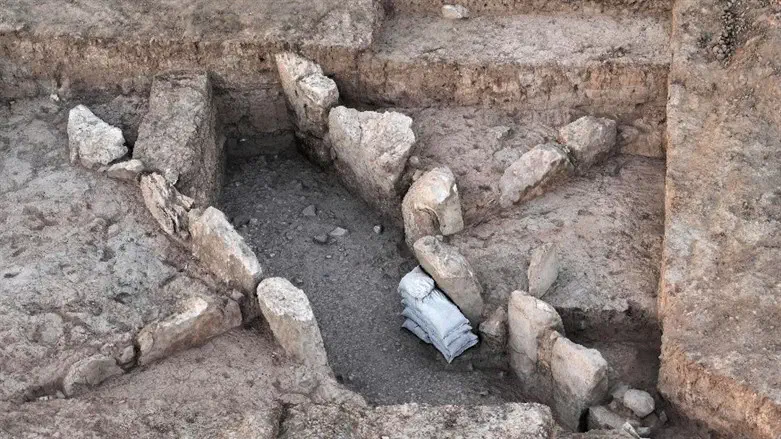
An ancient gate — the earliest known in the Land of Israel — was discovered recently at Tel Erani, near the Kiryat Gat Industrial Zone.
Over the last month, the Israel Antiquities Authority carried out an excavation funded by the Mekorot, the national water company of Israel, prior to laying a water pipe. During this excavation, a gate and part of a fortification system of the ancient city, dated to the Early Bronze IB, about 3,300 years ago, were found. These structures reflect the beginning of urbanization in the Land of Israel and the Southern Levant.
The earliest gate that was known until now was the gate at Tel Arad, that was dated about 300 years later than this gate.

The Tel Erani gate, which was preserved to a height of 1.5 m, is comprised of a passageway built of large stones that leads into the ancient city. Two towers made of large stones flank the gate, and between them there are rows of mudbricks. This gate is attached to the city walls that were uncovered in previous excavations.
According to the Mekorot Company, the archaeological excavations were conducted in conjunction with the construction of a new water pipeline designed to augment the water supply to Kiryat Gat in general, specifically focusing on supplying the water requirements of the Intel factory, a major water consumer.
The planned route of this new water line extends about 11 km, connecting the Plugot Junction area to the eastern part of Kiryat Gat. The pipe diameters range 48-60 inches with an estimated cost of 90 million NIS. During preliminary test drilling, archaeological artifacts were exposed, prompting the rescue excavations.
According to Emily Bischoff, Director of the excavation on behalf of the Israel Antiquities Authority: “This is the first time that such a large gate dating to the Early Bronze IB has been uncovered. In order to construct the gate and the fortification walls, stones had to be brought from a distance, mudbricks had to be manufactured and the fortification walls had to be constructed. This was not achieved by one or a few individuals. The fortification system is evidence of social organization that represents the beginning of urbanization.”

“It is probable that all passers-by, traders or enemies, who wanted to enter the city had to pass through this impressive gate,” says Martin-David Pasternak, Israel Antiquities Authority researcher of this period. “The gate not only defended the settlement, but also conveyed the message that one was entering an important strong settlement that was well-organized politically, socially and economically. This was the message to outsiders, possibly also to Egypt, where the process that would lead to the unification of the Lower and Upper Egypt under King Narmer was already beginning.”
Pasternak adds that, “At the end of the Early Bronze Age, the Egyptians themselves arrived here and settled the tell, and they reused the gate.”
According to Dr. Yitzhak Paz, Israel Antiquities Authority archaeologist specializing in the Early Bronze Age period, “Tel Erani, which is about 150 dunams in size, was an important early urban center in this area in the Early Bronze period. The tell site was part of a large and important settlement system in the southwestern area of the country in this period. Within this system we can identify the first signs of the urbanization process, including settlement planning, social stratification, and public building. The newly-uncovered gate is an important discovery that affects the dating of the beginning of the urbanization process in the country. The extensive excavations carried out by the Israel Antiquities Authority over recent years have led to dating the beginning of urbanization to the end of the fourth millenium BCE, but the excavations carried out at Tel Erani have now shown that this process began even earlier, in the last third of the fourth millennium BCE.”
Several archaeological excavations carried out at Tell Erani since the mid-1950s were directed by the Department of Antiquities, the Israel Antiquities Authority, Ben Gurion University of the Negev, and University of Krakow, Poland. The extensive research carried out at the tell have shown the importance of the questions and issues related to the beginning of urbanization: When did urbanization begin? What is a city? What are the characteristics of a city? Was there an Egyptian conquest or not?
“Following the excavation, the ancient gate, made of mudbricks, was covered up to protect it against erosion,” added Paz.
According to Eli Escusido, Director of Israel Antiquities Authority, “The discovery of the most ancient city gate known in the country, adds another important piece of knowledge to our archaeological knowledge. Together with the cooperation of the Mekorot Water Company, it was decided to move the water pipe in order to preserve the ancient gate.”
According to the Mekorot Company, the execution of the water line is slated to commence within 2023, with operations continuing throughout 2024. Mekorot stated that the positive cooperation with the Israel Antiquities Authority will continue at other sites in Israel.
